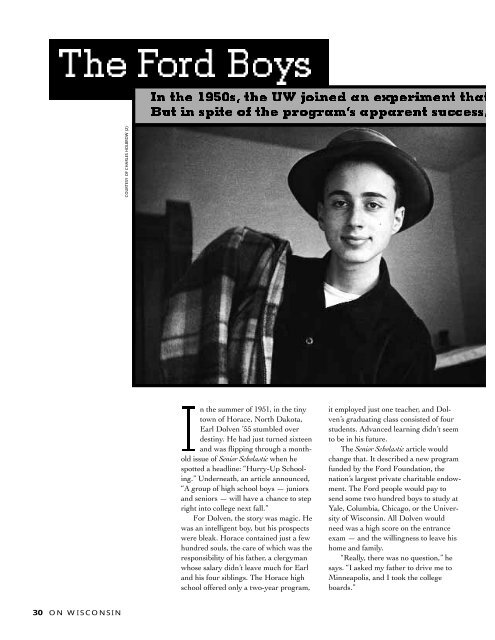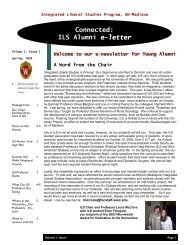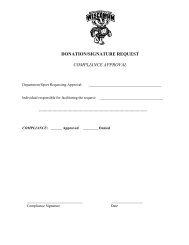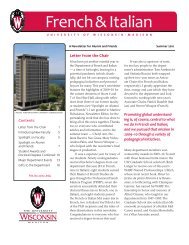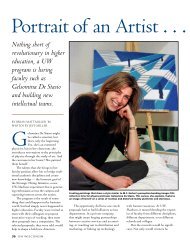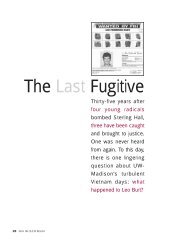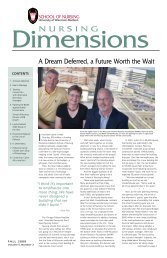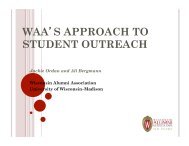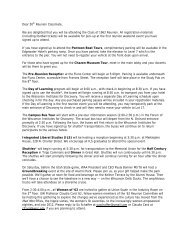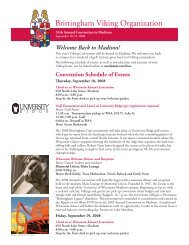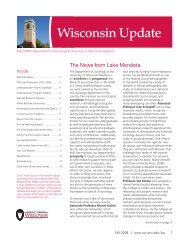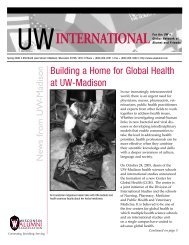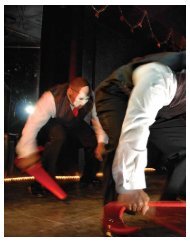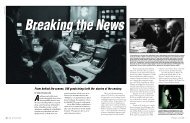The Ford Boys (pdf) - Wisconsin Alumni Association
The Ford Boys (pdf) - Wisconsin Alumni Association
The Ford Boys (pdf) - Wisconsin Alumni Association
- No tags were found...
You also want an ePaper? Increase the reach of your titles
YUMPU automatically turns print PDFs into web optimized ePapers that Google loves.
<strong>The</strong> <strong>Ford</strong> <strong>Boys</strong><br />
In the 1950s, the UW joined an experiment that<br />
But in spite of the program’s apparent success,<br />
COURTESY OF CHARLES HOLBROW (2)<br />
n the summer of 1951, in the tiny<br />
town of Horace, North Dakota,<br />
I<br />
Earl Dolven ’55 stumbled over<br />
destiny. He had just turned sixteen<br />
and was flipping through a monthold<br />
issue of Senior Scholastic when he<br />
spotted a headline: “Hurry-Up Schooling.”<br />
Underneath, an article announced,<br />
“A group of high school boys — juniors<br />
and seniors — will have a chance to step<br />
right into college next fall.”<br />
For Dolven, the story was magic. He<br />
was an intelligent boy, but his prospects<br />
were bleak. Horace contained just a few<br />
hundred souls, the care of which was the<br />
responsibility of his father, a clergyman<br />
whose salary didn’t leave much for Earl<br />
and his four siblings. <strong>The</strong> Horace high<br />
school offered only a two-year program,<br />
it employed just one teacher, and Dolven’s<br />
graduating class consisted of four<br />
students. Advanced learning didn’t seem<br />
to be in his future.<br />
<strong>The</strong> Senior Scholastic article would<br />
change that. It described a new program<br />
funded by the <strong>Ford</strong> Foundation, the<br />
nation’s largest private charitable endowment.<br />
<strong>The</strong> <strong>Ford</strong> people would pay to<br />
send some two hundred boys to study at<br />
Yale, Columbia, Chicago, or the University<br />
of <strong>Wisconsin</strong>. All Dolven would<br />
need was a high score on the entrance<br />
exam — and the willingness to leave his<br />
home and family.<br />
“Really, there was no question,” he<br />
says. “I asked my father to drive me to<br />
Minneapolis, and I took the college<br />
boards.”<br />
30 ON WISCONSIN
enrolled dozens of precocious teenagers.<br />
it’s never been repeated.<br />
BY JOHN ALLEN<br />
A thousand miles away, in Huntington<br />
Station, New York, John Israel ’55<br />
also had an appointment with fate. His<br />
father sold surgical and corset fabric to<br />
make women’s undergarments. “It wasn’t<br />
exactly Victoria’s Secret,” Israel says.<br />
<strong>The</strong> old man may not have had much<br />
formal schooling, but he was curious and<br />
read the New York Times, where he spotted<br />
a story, “Fund to Give <strong>Boys</strong> Pre-<br />
Draft Study,” which described the <strong>Ford</strong><br />
Foundation offer. “My father was very<br />
impressed with the University of <strong>Wisconsin</strong>,”<br />
says Israel, “and socially, I<br />
wasn’t very happy in high school. <strong>The</strong><br />
decision was a no-brainer.”<br />
Around the country, the same notice<br />
appeared in newspapers and magazines<br />
and on the bulletin boards of high school<br />
principals. From New York City’s elite<br />
Bronx High School of Science to oneroom<br />
rural schools, hundreds of boys<br />
(and a few girls) applied for the Pre-<br />
Induction Scholarship Program, later<br />
known as the Early Admission Experiment.<br />
<strong>The</strong>se were the <strong>Ford</strong> <strong>Boys</strong>, and<br />
their purpose was to challenge a basic<br />
assumption of the American education<br />
system, that a student had to be eighteen<br />
and a high school graduate to be emotionally<br />
and academically prepared for<br />
college life.<br />
<strong>The</strong> Fund saw America’s reliance on<br />
this regimented structure as the cause of<br />
a looming shortage of educated leaders.<br />
“In our own dynamic society,” wrote<br />
Philip Coombs, the Fund’s director of<br />
research, “it must be assumed that the<br />
demand for talent will continue to outstrip<br />
the supply. We will need more of<br />
every kind, not merely more nuclear<br />
physicists and engineers, but more firstrate<br />
biologists and doctors, teachers and<br />
politicians, economists and ministers,<br />
poets and philosophers.”<br />
Today, UW-Madison announces the<br />
number of prodigies entering as freshmen<br />
each year. In the five fall terms<br />
from 2000 to 2004, the UW has averaged<br />
just four new students aged sixteen<br />
or younger. Between 1951 and 1955,<br />
some 165 fifteen- and sixteen-year-olds<br />
enrolled at the UW, at a time when the<br />
university’s student population was only<br />
fourteen thousand, or a third of today’s<br />
total. <strong>The</strong> <strong>Ford</strong> <strong>Boys</strong> (and, eventually,<br />
Girls) became highly accomplished<br />
alumni, such as Raymond Damadian<br />
’56, who pioneered magnetic resonance<br />
imaging, and Roger Perkins ’55, former<br />
deputy associate director for research at<br />
Los Alamos National Laboratory, as<br />
well as dozens of doctors and lawyers,<br />
physicists and mathematicians.<br />
And yet, half a century later, the<br />
<strong>Ford</strong> <strong>Boys</strong> and the experiment that produced<br />
them are almost forgotten. What<br />
happened<br />
Once Upon a Time in<br />
Pyongyang ...<br />
<strong>The</strong> Early Admission Experiment was<br />
the unlikely product of two largely unrelated<br />
events during the summer of 1950.<br />
On June 25, the army of North Korea<br />
crossed the thirty-eighth parallel and<br />
invaded South Korea; on September 23,<br />
Congress passed the Revenue Act of<br />
1950.<br />
<strong>The</strong> start of the Korean War put<br />
massive pressure on the U.S. military,<br />
which had been gradually demobilizing<br />
since the end of World War II. <strong>The</strong> army<br />
had only about half a million soldiers<br />
in 1950, and as American and South<br />
Korean forces reeled backward that<br />
summer, the Pentagon realized it needed<br />
more men — some 3.5 million of them to<br />
meet the global Communist threat.<br />
Such numbers would require a massive<br />
overhaul of the draft, which allowed<br />
many young men to bypass service by<br />
Opposite: At 16, John Israel left his home<br />
on New York’s Long Island, where, he says,<br />
“socially, I wasn’t very happy.” Among the<br />
circle of friends he built in Madison was <strong>Ford</strong><br />
scholar Charlie Holbrow (above, modeling<br />
his ROTC uniform).<br />
Top: In 1952, Paul Thompson entered the<br />
UW at 15, although, he says, he lacked selfdiscipline.<br />
He flunked out once, dropped<br />
out once, and didn’t graduate until 1961.<br />
COURTESY OF PAUL THOMPSON<br />
SPRING 2005 31
COURTESY OF LOUISE TRUBEK (2)<br />
<strong>The</strong>re was no room for<br />
the <strong>Ford</strong> scholars in the<br />
UW’s residence halls, so<br />
their adviser, Herbert<br />
Howe, found them other<br />
accommodations. Louise<br />
Trubek (sitting on step,<br />
second from top) lived<br />
at Groves Co-Op during<br />
her junior year and<br />
found that the diverse<br />
mix of people there<br />
added another dimension<br />
to her education.<br />
<strong>The</strong> Conant Plan made college officials nervous. If all eighteen-year-old<br />
males entered the army, they reasoned, most would never return to school,<br />
depriving the country of a generation of talent.<br />
taking a student deferment and going to<br />
college. This not only deprived the armed<br />
forces of manpower, but many felt it was<br />
unfair. <strong>The</strong> editors of <strong>The</strong> Nation complained<br />
that exempting the college-bound<br />
created “an aristocracy of draft-proof<br />
students on the basis of aptitude tests and<br />
from the economically most fortunate<br />
groups. <strong>The</strong> dumb young men,” they<br />
noted sarcastically, “can do the fighting.”<br />
To address the inequity, a group<br />
called the Committee on the Present<br />
Danger suggested doing away with<br />
student deferments altogether. As it was<br />
led by Harvard University president<br />
James Conant and prominent scientist<br />
Vannevar Bush, many people listened —<br />
including George Marshall, the secretary<br />
of defense, who requested that Congress<br />
adopt the idea.<br />
<strong>The</strong> Conant Plan made college officials<br />
nervous. If all eighteen-year-old<br />
males entered the army, they reasoned,<br />
most would never return to school,<br />
depriving the country of a generation of<br />
talent. In January 1951, members of the<br />
<strong>Association</strong> of American Colleges met in<br />
Atlantic City, New Jersey, to voice their<br />
concerns. While they wrung their hands,<br />
Mark Ingraham MA’22, the UW’s dean<br />
of Letters and Science, met privately<br />
with his counterparts from Columbia,<br />
Yale, and Chicago to come up with a<br />
plan to deal with the looming problem.<br />
Aiming “to preserve the values of general,<br />
liberal education during the protracted<br />
period of emergency which the<br />
nation now faces,” they proposed running<br />
an experiment: suppose that America’s<br />
brightest young men were invited to<br />
college two years early — would they<br />
have the minds and maturity to handle<br />
the load<br />
<strong>The</strong> deans reasoned that boys who’d<br />
had a taste of college would be more<br />
likely to return after a hitch in the military.<br />
Moreover, they would provide the<br />
army with a nucleus of educated soldiers<br />
to fill emerging high-tech duties, especially<br />
in medicine. It seemed like a good<br />
plan for everyone — all the deans needed<br />
was someone to fund it.<br />
Enter the Revenue Act of 1950. Like<br />
the Conant Plan for the draft, this law<br />
tried to create a more equitable society,<br />
using taxation as its tool. Many in Congress<br />
felt that big businesses and wealthy<br />
families were using charitable foundations<br />
to conceal their money from the<br />
IRS. <strong>The</strong> Act opened foundation tax<br />
returns to public scrutiny so that the<br />
people (who, Congress reasoned, were<br />
supposed to be the charities’ ultimate<br />
beneficiaries) could know just how such<br />
funds were managed.<br />
<strong>The</strong> <strong>Ford</strong> Foundation was one of the<br />
targets of this provision. In 1950, it had<br />
a declared value of half a billion dollars,<br />
though some estimates put its actual<br />
value at $2.5 billion, significantly more<br />
than the assets of all other American<br />
foundations combined. But it had only<br />
paid out some $27 million for charitable<br />
works over the previous fifteen years. An<br />
internal study concluded that the foundation<br />
could afford to spend that much<br />
every year without depleting its endowment,<br />
and to some outsiders, it appeared<br />
32 ON WISCONSIN
<strong>The</strong>se institutions were less concerned with the draft than<br />
with the idea of changing education, and many of them dropped<br />
the gender requirement.<br />
to be nothing more than a vast holding<br />
company. <strong>The</strong> Revenue Act of 1950, with<br />
its threat of public scrutiny, gave the<br />
<strong>Ford</strong> Foundation incentive to spend its<br />
cash much more freely.<br />
In January 1951, the <strong>Ford</strong> Foundation<br />
appointed a new associate director,<br />
Robert Hutchins, who created within the<br />
foundation a Fund for the Advancement<br />
of Education. <strong>The</strong> deans saw in Hutchins<br />
their deliverance. As the former chancellor<br />
of the University of Chicago, he was<br />
not only one of their own, he was an educational<br />
iconoclast. He was highly critical<br />
of American schools and had pushed<br />
Chicago to take on more underage students.<br />
<strong>The</strong> deans applied to Hutchins, and<br />
the Fund for the Advancement of Education<br />
pledged $1.2 million to pay for the<br />
Pre-Induction Scholarship Experiment.<br />
Weeding Out the Twerps<br />
<strong>The</strong> experiment the deans designed was<br />
relatively straightforward. <strong>The</strong> schools<br />
were to recruit some two hundred high<br />
school students a year, then match them<br />
with “comparison groups” of students —<br />
eighteen-year-old freshmen with similar<br />
test scores and economic backgrounds.<br />
<strong>The</strong> institutions would follow each<br />
group’s academic development and social<br />
adjustment, and then submit their observations<br />
to the Fund for the Advancement<br />
of Education.<br />
<strong>The</strong> UW chose its prospective <strong>Ford</strong><br />
<strong>Boys</strong> based on a variety of criteria. First<br />
of all, applicants had to be males of the<br />
proper age (no older than sixteen years<br />
and six months on September 15, 1951).<br />
<strong>The</strong>y had to have the permission of their<br />
parents and principals and meet certain<br />
academic requirements, such as being in<br />
the top 10 percent of their high school<br />
class and scoring well on the College<br />
Entrance Examination Board, forerunner<br />
of the SAT. <strong>The</strong>n, because none of<br />
the schools wanted to end up with, as<br />
one of the deans put it, “a bunch of<br />
bright young twerps,” the students had<br />
to show evidence of social development,<br />
including interest in non-scholastic activities<br />
and a letter demonstrating their<br />
maturity.<br />
<strong>The</strong> program sparked immediate<br />
interest. Two thousand high-school students<br />
applied, and in the first year, the<br />
UW took in fifty-two, including Dolven<br />
and Israel. But it wasn’t just students who<br />
wanted in — other colleges did, too. By<br />
summer, the Fund had expanded its Early<br />
Admission Experiment to include eight<br />
more schools of varying size, location, and<br />
character. <strong>The</strong>re would be <strong>Ford</strong> students<br />
at the public Universities of Utah and<br />
Louisville, the private liberal arts colleges<br />
of Shimer, Oberlin, and Lafayette, the allwomen’s<br />
Goucher College, and the historically<br />
African-American Fisk and<br />
Morehouse Colleges. <strong>The</strong>se institutions<br />
were less concerned with the draft than<br />
with the idea of changing education,<br />
and many of them dropped the gender<br />
requirement. In 1953, the UW followed<br />
suit, adding <strong>Ford</strong> Girls to its mix.<br />
In 1951, only one of the UW’s <strong>Ford</strong><br />
<strong>Boys</strong> came from <strong>Wisconsin</strong>. <strong>The</strong> bulk of<br />
them — twenty-nine — came from New<br />
York, eight from the Bronx High School<br />
of Science. “<strong>The</strong> main thing that has<br />
made the <strong>Ford</strong> program a success,”<br />
wrote David Rothman ’54, MA’55, a<br />
member of that first class, “is that all the<br />
geniuses have been put next to each<br />
other. This knocks the ego out of some<br />
of the guys and promotes a rather fierce<br />
competition.”<br />
But if ferocity and a cosmopolitan<br />
flavor aided the program, they also created<br />
some of its biggest challenges. It<br />
would be up to one UW professor to<br />
make sure the <strong>Ford</strong> <strong>Boys</strong> received more<br />
benefit than pain.<br />
<strong>The</strong> Invaluable Mr. Chips<br />
“If you want to understand the <strong>Ford</strong> program,<br />
there are two things you need to<br />
know,” says Charles Stephenson ’55.<br />
“Herbert Howe and ILS.”<br />
Youth carried less stigma for the <strong>Ford</strong> Girls<br />
than it did for the <strong>Boys</strong>. Here, Trubek chats<br />
with fellow <strong>Ford</strong>ie Paul Friedman ’55.<br />
Howe MA’41, PhD’48, a professor of<br />
classics, was one of the most junior members<br />
of the UW faculty in 1951, and ILS,<br />
or Integrated Liberal Studies, is an interdisciplinary<br />
program that attempts to create<br />
a small, liberal-arts college atmosphere<br />
within the university. Both Howe and his<br />
wife, Evelyn PhD’46, taught within ILS.<br />
As the UW was collecting its <strong>Ford</strong><br />
<strong>Boys</strong> in the summer of 1951, Letters and<br />
Science dean Mark Ingraham tapped<br />
Howe to be the boys’ handler on campus.<br />
Howe had previously been a<br />
teacher at a preparatory school, and<br />
Ingraham thought his experience might<br />
help him relate to fifteen- and sixteenyear-old<br />
boys.<br />
“It was sort of an odd idea, really,”<br />
says Louise Trubek ’57, one of the first<br />
<strong>Ford</strong> Girls. Most of the experiment’s students<br />
had gone to public schools on the<br />
East or West Coast, and most of the UW<br />
students they met had attended public<br />
schools in the Midwest. Howe, she says,<br />
who “had taught Latin and Greek to<br />
prep school boys, was sort of a Mr.<br />
SPRING 2005 33
For many of the <strong>Ford</strong> students, the goal was simply to blend in. Some,<br />
like Dolven, who was tall for his age, concealed their participation from<br />
all but their closest acquaintances.<br />
COURTESY EVELYN THOMPSON<br />
Evelyn Thut Thompson ’57, MS’58 was<br />
thrilled to leave the “stultifying” environment<br />
of high school for the UW.<br />
Chips type. That wasn’t what we grew<br />
up with, nor was it what <strong>Wisconsin</strong> was<br />
like. And yet his efforts did help us find a<br />
home here.”<br />
As far as most of the <strong>Ford</strong> <strong>Boys</strong> were<br />
concerned, Howe’s chief purpose was to<br />
find them food and housing. Due to the<br />
program’s late start — recruiting hadn’t<br />
begun until May — the students couldn’t<br />
get space in the residence halls. Consequently,<br />
Howe spent much of the summer<br />
of 1951 making arrangements for<br />
the <strong>Ford</strong> <strong>Boys</strong> to stay in rooming houses.<br />
“Howe went pounding the hot streets of<br />
Madison to find us homes,” says Israel.<br />
“And to make sure that we ate, he and<br />
Eve would have us over to dinner on<br />
some Sundays. I can remember Howe<br />
having an ulcer and only being able to<br />
eat milk toast while the rest of us had<br />
roast lamb.”<br />
Howe heavily encouraged the <strong>Ford</strong><br />
<strong>Boys</strong> to enroll in ILS, and some 60 percent<br />
of them did. “It was a wonderful<br />
program,” says Wojciech Kolisinski ’55.<br />
“Its professors were outstanding, and its<br />
small size helped us adapt socially. We<br />
all knew we were smart, especially the<br />
group of us who had been at Bronx Science.<br />
But we felt we weren’t really with<br />
it in the social areas.”<br />
Nowhere was this more evident than<br />
in dating. “No self-respecting girl wanted<br />
to be seen with one of us,” says Kolisinski.<br />
“Howe made valiant attempts. He<br />
even brought around high-school students<br />
for us to date. But it wasn’t really<br />
until the third year, when they let girls<br />
into the program, that things got any<br />
better.”<br />
Howe was not just the students’<br />
procurer — he was also their protector,<br />
keeping an eye on the students’ progress,<br />
maintaining records for the <strong>Ford</strong> Foundation,<br />
and trying to smooth their various<br />
troubles. When one <strong>Ford</strong> Boy was<br />
caught in a panty raid, Howe helped<br />
keep him from being expelled. When<br />
another refused to join ROTC, a requirement<br />
for all male students, Howe worked<br />
with the boy and campus officials to<br />
resolve the situation.<br />
“On the whole, they did very well,”<br />
he says. “I always felt it was surprising<br />
how little trouble they had adjusting.”<br />
Still, the 1950s weren’t necessarily an<br />
easy time to be on campus, especially for<br />
those who were young and liberal and<br />
from New York. <strong>Wisconsin</strong>’s junior senator,<br />
Joseph McCarthy, was at the height<br />
of his influence, and the politics of some<br />
of the <strong>Ford</strong> <strong>Boys</strong> didn’t endear them to<br />
conservative <strong>Wisconsin</strong>ites. Henry<br />
Wortis ’55 and Arnold Lieber ’55, for<br />
instance, headed the Labor Youth<br />
League, which the House Un-American<br />
Activities Committee had labeled a<br />
Communist front organization.<br />
“Really, what we think of as the politics<br />
of the 1960s were born in Madison<br />
in the 1950s,” says Trubek, who served<br />
on the university’s Human Relations<br />
Committee, which promoted a sometimes-unpopular<br />
campaign for racial<br />
integration in fraternities and sororities.<br />
“A lot of that had to do with the <strong>Ford</strong><br />
program — with this influx of people<br />
from around the country, all very bright<br />
and motivated.”<br />
“Occasionally you’d hear politicians<br />
complain about the New York radical<br />
element on campus,” says Israel. “And<br />
there was perhaps a bit of anti-Semitism<br />
in that. It was at <strong>Wisconsin</strong> that I heard<br />
the word Jew used as a verb for the<br />
first time.”<br />
For many of the <strong>Ford</strong> students, the<br />
goal was simply to blend in. Some, like<br />
Dolven, who was tall for his age, concealed<br />
their participation from all but<br />
their closest acquaintances. Others<br />
weren’t so lucky. In an essay he wrote<br />
just before graduation, Charlie Holbrow<br />
’55, MS’60, PhD’63 warned that “<strong>Ford</strong><br />
students are generally not emotionally<br />
equipped for college.” He recommended<br />
that “better psychological, emotional,<br />
and adaptive screening should be instituted,<br />
and size should be of quite a bit of<br />
importance. Mature individuals, both<br />
physically and mentally, should be<br />
obtained, or none at all.”<br />
Academically, however, the <strong>Ford</strong><br />
<strong>Boys</strong> tended to excel. In grades and on<br />
standardized tests, they scored better<br />
than the comparison group and far better<br />
than the general student population.<br />
Fewer <strong>Ford</strong> students flunked out or withdrew<br />
than did the comparisons, and they<br />
were more likely to enter post-graduate<br />
education. Approximately 90 percent of<br />
<strong>Ford</strong> scholars reported that the program<br />
was profitable to them personally, that<br />
they would recommend taking part to a<br />
friend, and that they felt the program<br />
should become a regular part of the<br />
admission policies of American colleges.<br />
After the first two <strong>Ford</strong> classes — one<br />
hundred boys — had finished their program,<br />
Howe wrote that “forty or fifty<br />
have benefited greatly [from early admission],<br />
about as many more have not been<br />
harmed, and perhaps three or four would<br />
have been better off if they had not taken<br />
the scholarship.” About the program in<br />
general, he was very positive. “Perhaps I<br />
am over-optimistic, but I cannot see that<br />
[the boys] have suffered any permanent<br />
harm to offset the intellectual gains they<br />
have made.”<br />
<strong>The</strong> Fund for the Advancement of<br />
Education published two reviews of the<br />
experiment while it was still in progress:<br />
34 ON WISCONSIN
Though they retired in the 1980s, Herb and Evelyn Howe still keep in touch with many former<br />
<strong>Ford</strong> scholars, such as Earl Dolven (right). In 2000, many <strong>Ford</strong>ies returned to Madison to create<br />
a named professorship in the Howes’ honor.<br />
Bridging the Gap between School and College<br />
in 1953 and <strong>The</strong>y Went to College Early in<br />
1957. Both studies trumpeted the program’s<br />
achievements, the second concluding,<br />
“It has become increasingly<br />
clear that ... we must not fail to provide<br />
for the fullest possible development for<br />
our ablest young people. <strong>The</strong> Fund for<br />
the Advancement of Education believes<br />
that the Early Admission Experiment<br />
has clearly demonstrated its promise as a<br />
means to that end.”<br />
But that was the last the Fund had to<br />
say about the <strong>Ford</strong> <strong>Boys</strong>. It never examined<br />
the study again.<br />
“In the end the program was just an<br />
experiment,” says Howe. “<strong>The</strong> classes<br />
ran their course, the grant ran out, and it<br />
came to an end.”<br />
Meanwhile in the Cold War ...<br />
But the program was the victim of more<br />
than an expiration date. Throughout the<br />
1950s, the pillars of support for the<br />
Early Admission Experiment fell away<br />
one by one.<br />
In 1953, the fighting in Korea<br />
stopped. <strong>The</strong>re was no peace, only an<br />
armistice, but that was enough to alleviate<br />
the Pentagon’s personnel crunch.<br />
Talk of a universal draft ceased.<br />
In 1954, the <strong>Ford</strong> <strong>Boys</strong>’ most powerful<br />
advocate departed. Increasingly<br />
worried about McCarthyism, Robert<br />
Hutchins left the Fund for the Advancement<br />
of Education, becoming instead the<br />
president of the <strong>Ford</strong> Foundation’s Fund<br />
for the Republic, which was concerned<br />
with protecting civil liberties.<br />
Worse, the program began to meet<br />
resistance within high schools, which<br />
were growing reluctant to surrender<br />
their best students to college ahead of<br />
schedule. Sensing a need to be diplomatic<br />
with education officials, the UW<br />
gave the Early Admission Experiment a<br />
cautious review. In 1957, when the Fund<br />
for the Advancement of Education gave<br />
its final evaluation of the <strong>Ford</strong> <strong>Boys</strong>, the<br />
university reversed Howe’s appraisal:<br />
“Our experience shows that early admission<br />
demands what appears to be an<br />
unusual combination of intellectual and<br />
social precocity. It is probably not as rare<br />
as it seems on the surface; there may be<br />
as many as a fifth of most high school<br />
classes who could make the grade. But<br />
the vast majority of these would probably<br />
gain nothing by early admission, and<br />
the principals have undoubtedly been<br />
wise when they have hesitated in recommending<br />
many applicants.” Of the twelve<br />
schools involved in the study, only the<br />
UW declined to make a standard policy<br />
to accommodate early admissions.<br />
Today, the university remains reluctant<br />
to welcome high-school age students<br />
into the student body. A high school<br />
diploma is a requirement for all incoming<br />
freshmen, and though Rob Seltzer, UW-<br />
Madison’s director of admissions, can<br />
waive that requirement for particularly<br />
qualified students, he very seldom does.<br />
“It’s a UW System policy,” he says.<br />
“High schools really wouldn’t be happy<br />
if colleges came along and raided all of<br />
their best kids. <strong>The</strong>ir statistics would<br />
start to look awful, and then No Child<br />
Left Behind gets after them.”<br />
But for most of the <strong>Ford</strong> <strong>Boys</strong> and<br />
Girls, the program opened a path to a<br />
brighter future. “At the very least,” says<br />
Howe, “most of them managed to avoid<br />
the draft.”<br />
Holbrow, who felt the program didn’t<br />
pay enough attention to the students’<br />
maturity, picked up a bachelor’s in history<br />
and graduate degrees in physics and<br />
served on the faculty at Colgate University.<br />
He remains friends with several other<br />
<strong>Ford</strong> alumni, including Israel, who did<br />
graduate study at Harvard and became a<br />
professor of Chinese history at the University<br />
of Virginia. Romantic entanglements<br />
continued to haunt Kolisinski, who earned<br />
a degree in physics, and then fell in love<br />
with a friend’s fiancée and dropped out of<br />
graduate school to join the army. He eventually<br />
earned a PhD and now works in<br />
aerospace. And Dolven, who escaped<br />
Horace, North Dakota, earned a degree in<br />
mathematics. Along with David Rothman,<br />
he spent a year doing post-graduate math<br />
study at Harvard before leaving to work<br />
for Rocketdyne in Los Angeles. Today he’s<br />
an attorney in Berkeley, California.<br />
“<strong>Ford</strong> brought together a unique<br />
combination of the young and successful,”<br />
says Louise Trubek, who studied<br />
law at Yale and is now on the faculty of<br />
UW-Madison’s Law School. “That gave<br />
me a sense of courage the rest of my life.<br />
It really is a shame that this program isn’t<br />
done anymore.”<br />
John Allen, associate editor of On <strong>Wisconsin</strong>, was<br />
not a <strong>Ford</strong> Boy, though he has driven a<br />
SPRING 2005 35


